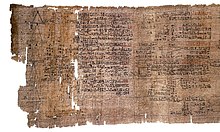
Ahmes (Ancient Egyptian: jꜥḥ-ms “, a common Egyptian name also transliterated Ahmose) was an ancient Egyptian scribe who lived towards the end of the Fifteenth Dynasty (and of the Second Intermediate Period) and the beginning of the Eighteenth Dynasty (and of the New Kingdom). He transcribed the Rhind Mathematical Papyrus, a work of ancient Egyptian mathematics that dates to approximately 1550 BC;[1] he is the earliest contributor to mathematics whose name is known.[2][3] Ahmes claimed not to be the writer of the work but rather just the scribe. He claimed the material came from an even older document from around 2000 B.C.[4]
See also[edit]
References[edit]
- ^ "The Rhind Mathematical Papyrus". britishmuseum.org. Retrieved 2017-09-18.
- ^ Pickover, Clifford A. (2009), The Math Book: From Pythagoras to the 57th Dimension, 250 Milestones in the History of Mathematics, Sterling Publishing Company, Inc., p. 36, ISBN 978-1-4027-5796-9.
- ^ Derbyshire, John (2006), Unknown quantity: a real and imaginary history of algebra, National Academies Press, p. 29, ISBN 978-0-309-09657-7.
- ^ "Ahmes - Biography".
Well, that’s interesting to know that Psilotum nudum are known as whisk ferns. Psilotum nudum is the commoner species of the two. While the P. flaccidum is a rare species and is found in the tropical islands. Both the species are usually epiphytic in habit and grow upon tree ferns. These species may also be terrestrial and grow in humus or in the crevices of the rocks.
View the detailed Guide of Psilotum nudum: Detailed Study Of Psilotum Nudum (Whisk Fern), Classification, Anatomy, Reproduction